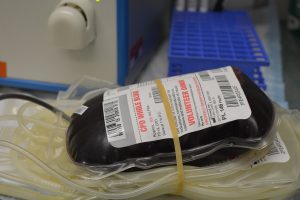
Donating blood is one of the easiest ways to give back to the community.Did you know that CCE staff schedule multiple blood drives on campus every year? Bonfils Blood Center and Penrose-St. Francis Blood Bank both come and accept donations for two days each semester, and Bonfils is here for another day each summer. You can find their welcoming and professionally trained staff in Worner.
Donating blood is highly regulated by the FDA and is very safe. Sterile, disposable needles and supplies are used once and are safely discarded after each donation. You cannot get HIV/AIDS or any other disease by donating blood.
From the time you first arrive, the process takes less than an hour – but typically only 5-10 minutes of that will be actually be the donation. The rest consists of a short medical history and mini-physical.
Typically, donating blood has four steps:
- Registration: You will be asked to provide basic information about yourself such as your name, address and age. You will then be instructed to read or review important donor information.
- Medical History Interview: After answering a series of personal questions about your medical history, a blood bank professional will escort you into a private interview area. There you will be asked additional confidential questions and your medical history assessed for donation eligibility.
- Mini Physical and Blood Donation: A drop of blood will be taken from your finger and analyzed for red blood cell concentration. This process will assure blood bank staff that your red blood cell count is adequate for you to donate. Your blood pressure, temperature and pulse rate are taken. After all requirements are met, a phlebotomist will cleanse and sterilize an area of your arm. A sterile needle is then inserted in your arm to collect the blood. The collection process will take about 5-10 minutes.
- Refreshments: After the donation is completed, you will relax and enjoy juice and tasty snacks. This recovery time will aid your body in replacing the volume you lost during the donation.
Donor & Medical Requirements:
In general, donors must:
- be in good health
- weigh at least 110 pounds
- be symptom free of cold or flu
- be 18 years of age (if 16 or 17-years-old, may donate with written parental consent)
- From now on – TATTOOS ARE ACCEPTABLE if the tattoo was applied in a state-regulated shop within the last 12 months
Many medications are acceptable for blood donations including those for high blood pressure, cholesterol and diabetes. If you were deferred in the past from donating blood, please try again. Most deferrals are temporary and deferral restrictions may change.
Interested in participating?
Penrose-St. Francis will be staffing the next blood drive on Wednesday, December 6th and Thursday, December 7th, from 12:00pm-3:00pm in the Worner Lounge. Penrose Blood Bank accepts donors at age 16 with parental consent. Please call 719-776-5822 if you have questions. All donors must have a driver’s license, and walk-Ins are welcome.
While you are deciding whether you should donate blood or note, here are some interesting factsabout blood donation in the United States:
- 5 million Americans will a need blood transfusion each year
- Someone needs blood every two seconds
- Only 37 percent of the U.S. population is eligible to donate blood – less than 10 percent do annually
- One pint of blood can save up to three lives
- 5 gallons: amount of blood you could donate if you begin at age 17 and donate every 56 days until you reach 79 years old
- If there are 100 people in a room, 46 will have type O blood, 40 will have type A, 10 will have type B and four will have type AB
- Shortages of all blood types happen during the summer and winter holidays
- Giving blood will not decrease your strength
For more information about blood donation and other programs that Bonfils Blood Center and Penrose Hospital have visit their websites: http://bonfils.org/ and https://www.centura.org/locations/penrose-st-francis-health-services/community-programs#giving-blood.
Information provided by Bonfils Blood Center and Penrose St. Francis Blood Bank, compiled by Julia Bazavluk.

